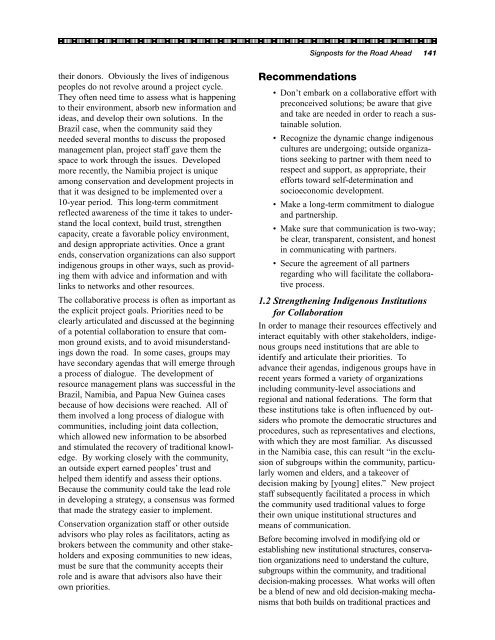Indigenous Peoples and Conservation Organizations
Indigenous Peoples and Conservation Organizations
Indigenous Peoples and Conservation Organizations
Create successful ePaper yourself
Turn your PDF publications into a flip-book with our unique Google optimized e-Paper software.
Signposts for the Road Ahead 141<br />
their donors. Obviously the lives of indigenous<br />
peoples do not revolve around a project cycle.<br />
They often need time to assess what is happening<br />
to their environment, absorb new information <strong>and</strong><br />
ideas, <strong>and</strong> develop their own solutions. In the<br />
Brazil case, when the community said they<br />
needed several months to discuss the proposed<br />
management plan, project staff gave them the<br />
space to work through the issues. Developed<br />
more recently, the Namibia project is unique<br />
among conservation <strong>and</strong> development projects in<br />
that it was designed to be implemented over a<br />
10-year period. This long-term commitment<br />
reflected awareness of the time it takes to underst<strong>and</strong><br />
the local context, build trust, strengthen<br />
capacity, create a favorable policy environment,<br />
<strong>and</strong> design appropriate activities. Once a grant<br />
ends, conservation organizations can also support<br />
indigenous groups in other ways, such as providing<br />
them with advice <strong>and</strong> information <strong>and</strong> with<br />
links to networks <strong>and</strong> other resources.<br />
The collaborative process is often as important as<br />
the explicit project goals. Priorities need to be<br />
clearly articulated <strong>and</strong> discussed at the beginning<br />
of a potential collaboration to ensure that common<br />
ground exists, <strong>and</strong> to avoid misunderst<strong>and</strong>ings<br />
down the road. In some cases, groups may<br />
have secondary agendas that will emerge through<br />
a process of dialogue. The development of<br />
resource management plans was successful in the<br />
Brazil, Namibia, <strong>and</strong> Papua New Guinea cases<br />
because of how decisions were reached. All of<br />
them involved a long process of dialogue with<br />
communities, including joint data collection,<br />
which allowed new information to be absorbed<br />
<strong>and</strong> stimulated the recovery of traditional knowledge.<br />
By working closely with the community,<br />
an outside expert earned peoples’ trust <strong>and</strong><br />
helped them identify <strong>and</strong> assess their options.<br />
Because the community could take the lead role<br />
in developing a strategy, a consensus was formed<br />
that made the strategy easier to implement.<br />
<strong>Conservation</strong> organization staff or other outside<br />
advisors who play roles as facilitators, acting as<br />
brokers between the community <strong>and</strong> other stakeholders<br />
<strong>and</strong> exposing communities to new ideas,<br />
must be sure that the community accepts their<br />
role <strong>and</strong> is aware that advisors also have their<br />
own priorities.<br />
Recommendations<br />
• Don’t embark on a collaborative effort with<br />
preconceived solutions; be aware that give<br />
<strong>and</strong> take are needed in order to reach a sustainable<br />
solution.<br />
• Recognize the dynamic change indigenous<br />
cultures are undergoing; outside organizations<br />
seeking to partner with them need to<br />
respect <strong>and</strong> support, as appropriate, their<br />
efforts toward self-determination <strong>and</strong><br />
socioeconomic development.<br />
• Make a long-term commitment to dialogue<br />
<strong>and</strong> partnership.<br />
• Make sure that communication is two-way;<br />
be clear, transparent, consistent, <strong>and</strong> honest<br />
in communicating with partners.<br />
• Secure the agreement of all partners<br />
regarding who will facilitate the collaborative<br />
process.<br />
1.2 Strengthening <strong>Indigenous</strong> Institutions<br />
for Collaboration<br />
In order to manage their resources effectively <strong>and</strong><br />
interact equitably with other stakeholders, indigenous<br />
groups need institutions that are able to<br />
identify <strong>and</strong> articulate their priorities. To<br />
advance their agendas, indigenous groups have in<br />
recent years formed a variety of organizations<br />
including community-level associations <strong>and</strong><br />
regional <strong>and</strong> national federations. The form that<br />
these institutions take is often influenced by outsiders<br />
who promote the democratic structures <strong>and</strong><br />
procedures, such as representatives <strong>and</strong> elections,<br />
with which they are most familiar. As discussed<br />
in the Namibia case, this can result “in the exclusion<br />
of subgroups within the community, particularly<br />
women <strong>and</strong> elders, <strong>and</strong> a takeover of<br />
decision making by [young] elites.” New project<br />
staff subsequently facilitated a process in which<br />
the community used traditional values to forge<br />
their own unique institutional structures <strong>and</strong><br />
means of communication.<br />
Before becoming involved in modifying old or<br />
establishing new institutional structures, conservation<br />
organizations need to underst<strong>and</strong> the culture,<br />
subgroups within the community, <strong>and</strong> traditional<br />
decision-making processes. What works will often<br />
be a blend of new <strong>and</strong> old decision-making mechanisms<br />
that both builds on traditional practices <strong>and</strong>

















